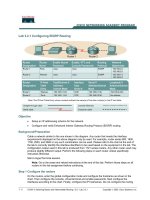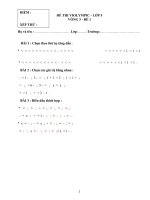5 12 3, 2, 1, blastoff (Scott Foresman)
Bạn đang xem bản rút gọn của tài liệu. Xem và tải ngay bản đầy đủ của tài liệu tại đây (4.7 MB, 10 trang )
3, 2, 1, Blastoff!
Fascinating Facts
• Two dogs, Belka and Strelka, were aboard the
Soviets’ Sputnik 5 in 1960. They returned unharmed
after a day in orbit. Strelka later gave birth to six
healthy puppies. One puppy was given as a gift to
President Kennedy.
• Depending on where you are on Earth, where the
spacecraft is, and the time of day, you can see the
International Space Station without a telescope.
• Much of the Internet began as a Cold War project to
create a communication system that could survive
a nuclear attack.
Genre
Nonfiction
Comprehension Skill
Cause and Effect
Text Features
• Sidebars
• Captions
Scott Foresman Social Studies
ISBN 0-328-14915-2
ì<(sk$m)=bejbf < +^-Ä-U-Ä-U
By Maureen Blaney Flietner
Write to It!
In this book you will read about a race into space
between countries that had different beliefs about
freedom. This race now has turned into a chance
for the two countries to work together.
3, 2, 1, Blastoff!
What part of the space race did you find most
interesting? Write a paragraph summarizing that
part and explain why it interests you.
Write your paragraph on a separate sheet of paper.
Vocabulary
communism
propaganda
arms race
satellite
space race
By Maureen Blaney Flietner
Photographs
Every effort has been made to secure permission and provide appropriate credit for photographic material. The publisher deeply
regrets any omission and pledges to correct errors called to its attention in subsequent editions.
Unless otherwise acknowledged, all photographs are the property of Scott Foresman, a division of Pearson Education.
Photo locators denoted as follows: Top (T), Center (C), Bottom (B), Left (L), Right (R), Background (Bkgd)
ISBN: 0-328-14915-2
Copyright © Pearson Education, Inc.
All Rights Reserved. Printed in the United States of America. This publication is protected
by Copyright, and permission should be obtained from the publisher prior to any prohibited
reproduction, storage in a retrieval system, or transmission in any form by any means,
electronic, mechanical, photocopying, recording, or likewise. For information regarding
permission(s), write to: Permissions Department, Scott Foresman, 1900 East Lake Avenue,
Glenview, Illinois 60025.
1 2 3 4 5 6 7 8 9 10 V0G1 14 13 12 11 10 09 08 07 06 05
Opener: ©NASA Human Space Flight Gallery, (Bkgd) ©Getty Images
2 ©Getty Images
3 ©Corbis
4 ©Time Life Pictures/Getty Images
5 ©Peter Turnley/Corbis
6 ©Mark Wade
7 ©Mark Wade
9 ©Bettmann/Corbis
Editorial Offices: Glenview, Illinois • Parsippany, New Jersey • New York, New York
10 ©Novosti/Photo Researchers, Inc.
11 ©Corbis
Sales Offices: Needham, Massachusetts • Duluth, Georgia • Glenview, Illinois
13 ©NASA Human SpaceCoppell,
Flight Gallery
Texas • Sacramento, California • Mesa, Arizona
14 (T) ©Stephen Marks/Getty Images, (B) ©Bob Winsett/Index Stock Imagery
15 (L, R) ©Getty Images
Missiles and Rockets
Blastoff!
To defeat its enemies in World War II, the United States
and its allies fought on the same side as the Soviet Union.
The Soviet Union’s leaders believed in communism. Under
communism the government owns all the businesses and all
the land. Communism was very different from what Americans
believe. Americans believe in many personal freedoms.
World War II saw the use of many powerful weapons.
When the war ended in Europe, the United States and the
Soviet Union wanted to learn about some German weapons.
One German weapon was called the V-1 or “buzz bomb,”
because it made a buzzing sound when it flew.
What is the difference between a rocket and a missile?
A rocket is an engine that moves by burning fuel. The
burning fuel makes gases that shoot out the back of the
engine. When the gases shoot out, they push the rocket, or
engine, forward.
A missile is a rocket that carries a weapon.
A ballistic missile is one that uses an engine to fly very
high into the sky. After it reaches the sky and flies along a
flight path, the engine turns off. The missile falls because of
gravity until it hits its target.
The V-1 was used by Germany
during World War II.
Another weapon was called
a V-2 missile. It had an engine
that carried it up into the sky
and then let it fall by the force
of gravity to its target. It could
send a large bomb more than
150 miles in only five minutes.
A captured V-2 missile was tested in
the United States after World War II.
2
3
Opposing Views
When World War II ended, the United States wanted to
help its allies, and even its former enemies. The United States
wanted these countries to become strong and free.
The Soviet Union did not want Germany and other countries
to be strong. Because it worried that strong countries might
attack it, the Soviet Union forced the countries it controlled at
the end of the war to accept communism. The people in those
countries were no longer free.
The United States and its allies flew supplies into West Berlin,
Germany, when the Soviets tried to control the whole city.
The Soviet Union held parades to show off its weapons.
The United States and the Soviet Union had fought together
to win the war. Now they were enemies and did not trust each
other. The Cold War had started.
It was a time of propaganda. The Soviet Union told
people that communism was powerful. The Soviet Union held
big parades to show off its tanks, missiles, and weapons.
The United States told people that freedom was good and
important. The United States used radio programs to tell
people in communist countries that the American ideology
worked.
4
5
Because the two countries did not trust
each other, both sides wanted to be ready
in case the other attacked. In the United
States, scientists tested and built missiles
and rockets such as the Viking. In the Soviet
Union, scientists built one missile called the
R-5.
Each side was busy making weapons,
or arms. It had become a race. Each side
wanted to have more powerful weapons
than the other side. It was an arms race.
The Cold War was dividing the world. To
help communism spread, the Soviet Union
helped other communist governments. As a
result the United States helped countries that
were not communist.
The Cold War led to real fighting. Wars
were fought in Korea and Vietnam to stop
the spread of communism.
The R-5 missile could
travel up to 750 miles.
6
The Space Race
In 1952 scientists asked countries to make satellites.
Satellites are objects that orbit, or circle, Earth. The scientists
wanted to use the satellites to make a map of Earth.
In 1957 the Soviets surprised the world by building a missile
called an R-7. The R-7 was the first ballistic missile that could
go a very long distance. It could even go between continents.
It was called an intercontinental ballistic missile, or ICBM. R-7
was powerful enough to send a nuclear bomb all the way to
the United States or carry a spacecraft into orbit.
A few months later, the Soviet Union sent the world’s first
satellite into space. Sputnik 1 was only the size of a basketball,
but it was much bigger than the small satellite the United States
had planned to launch. The space race had begun!
The R-7 missile was the first ICBM.
7
Dog in Space!
Less than a month later, the Soviet Union launched
Sputnik 2. This spacecraft carried a passenger, a dog
named Laika.
The United States wanted to launch a satellite into
space. It started a second satellite program called
Explorer. On January 31, 1958, the United States
successfully launched its first satellite. It was called the
Explorer I.
The United States wanted to do more in space.
It started the National Aeronautics and Space
Administration (NASA). NASA would lead America’s
way in exploring space.
At the same time, both the Soviet Union and the United
States were getting better at building missiles. Missiles
now could carry many weapons, and they were more
accurate.
Laika, a small Russian dog, became the world’s first space
traveler. She was on Sputnik 2 so Soviet scientists could find
out if a living creature could be sent into orbit. Laika became
famous. Her picture was on postage stamps in different
countries. Songs were written about her.
Laika was the first living creature in space.
8
9
In 1959 the Soviet Union again scored a first by sending a
spacecraft around the Moon.
In 1961 the Soviet Union sent the first person into space. The
Soviets called their space travelers cosmonauts. A cosmonaut
named Yuri Gagarin circled Earth and came back safely.
A month later, Alan Shepard became the first American
to fly into space. Americans called their space travelers
astronauts. Several months later, astronaut John Glenn became
the first American to orbit Earth.
Yuri Gagarin was the first
person sent into space.
Alan Shepard was the first American to fly into space.
President John F. Kennedy told the world that the space race
would end with the landing of a man on the Moon. The space
race was now a race to the Moon.
The United States was busy. NASA’s Project Mercury
program studied whether people could live in space. The
Project Gemini program showed how two astronauts could fly
and work on a spacecraft. The Project Apollo program studied
how to land Americans on the Moon and bring them safely
back to Earth.
11
Doing the Moon Walk!
On July 20, 1969, astronaut Neil Armstrong stepped off
the landing craft and onto the Moon. He said: “That’s one
small step for man, one giant leap for mankind.”
Astronaut Edwin “Buzz” Aldrin followed him onto the
Moon’s surface. The two astronauts walked around and
collected rocks to study.
The United States had won the space race. They had put a
man on the Moon before the Soviet Union.
The race to the Moon was over, but the Soviets still
worked on other space projects. In 1971 they sent the
world’s first space station called Salyut, into orbit. Later, they
replaced Salyut with another space station called Mir.
The United States worked on other projects as well. NASA
built a new vehicle called the space shuttle. It also launched
a space station called Skylab. Skylab showed Americans
that people could live and work in space for months at a
time.
The Cold War ended in the early 1990s when the Soviet
Union fell apart. Russia, the biggest country that had been
a part of the Soviet Union, now started working with the
United States on space projects.
Astronaut Neil Armstrong
took this photo of Edwin
“Buzz” Aldrin on the Moon.
12
13
Cool Tools from the Space Race
During the space race, scientists had to think up new ways
to do things. The things they learned and made now help
people in many ways. Here are just a few things we have
because of space projects.
Smoke Detector
Equipment used to detect
poisonous gases in Skylab
now lets people know if
there are fires in buildings
and homes.
Firefighter Suit
Safer firefighter suits are made from the same
fabric used for astronauts’ space suits.
14
Computer Joystick
This stick was created by
scientists who tried to figure
out how to control robots that
explored the Moon’s surface.
Ear Thermometer
Ear thermometers use the same
technology scientists used as they
tried to detect new stars.
Many good things have come from the space age. More
may be ahead. Today, the United States and other countries
are working together on the biggest science project of all: the
International Space Station.
On the International Space Station, scientists can study
Earth to see how it is changing. They can look for new and
better ways of doing things.
The United States, through NASA, continues to explore
space. The United States even plans to send astronauts back to
the Moon someday. It also plans to send humans to Mars . . .
and beyond.
15
Write to It!
In this book you will read about a race into space
Glossary
between countries that had different beliefs about
arms race a race to build more and better weapons than the
freedom. This race now has turned into a chance
enemy
for the has
two countries to work together.
communism a political and economic system in which the
government owns all businesses and land
What part of the space race did you find most
interesting? Write a paragraph summarizing that
part and explain why it interests you.
Write your paragraph on a separate sheet of paper.
Vocabulary
propaganda a systematic effort to spread opinions or
communism
beliefs
propaganda
satellite an object that is sent into space and orbits Earth
arms race
space race a race between
the United States and the Soviet
satellite
Union to explore outerspace
spacerace
during the Cold War
Photographs
Every effort has been made to secure permission and provide appropriate credit for photographic material. The publisher deeply
regrets any omission and pledges to correct errors called to its attention in subsequent editions.
Unless otherwise acknowledged, all photographs are the property of Scott Foresman, a division of Pearson Education.
Photo locators denoted as follows: Top (T), Center (C), Bottom (B), Left (L), Right (R), Background (Bkgd)
ISBN: 0-328-14915-2
Copyright © Pearson Education, Inc.
All Rights Reserved. Printed in the United States of America. This publication is protected
by Copyright, and permission should be obtained from the publisher prior to any prohibited
reproduction, storage in a retrieval system, or transmission in any form by any means,
electronic, mechanical, photocopying, recording, or likewise. For information regarding
permission(s), write to: Permissions Department, Scott Foresman, 1900 East Lake Avenue,
Glenview, Illinois 60025.
1 2 3 4 5 6 7 8 9 10 V0G1 14 13 12 11 10 09 08 07 06 05
16
Opener: ©NASA Human Space Flight Gallery, (Bkgd) ©Getty Images
2 ©Getty Images
3 ©Corbis
4 ©Time Life Pictures/Getty Images
5 ©Peter Turnley/Corbis
6 ©Mark Wade
7 ©Mark Wade
9 ©Bettmann/Corbis
10 ©Novosti/Photo Researchers, Inc.
11 ©Corbis
13 ©NASA Human Space Flight Gallery
14 (T) ©Stephen Marks/Getty Images, (B) ©Bob Winsett/Index Stock Imagery
15 (L, R) ©Getty Images









